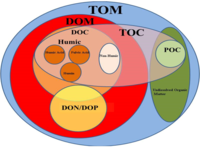The mesopause is the point of minimum temperature at the boundary between the mesosphere and the thermosphere atmospheric regions. Due to the lack of solar heating and very strong radiative cooling from carbon dioxide, the mesosphere is the coldest region on Earth with temperatures as low as -100 °C. The altitude of the mesopause for many years was assumed to be at around 85 km (53 mi), but observations to higher altitudes and modeling studies in the last 10 years have shown that in fact there are two mesopauses - one at about 85 km and a stronger one at about 100 km (62 mi), with a layer of slightly warmer air between them.
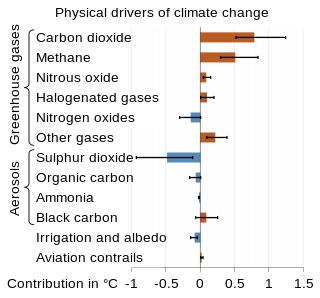
Radiative forcing is a concept used in climate science to quantify the change in energy balance in the Earth's atmosphere caused by various factors, such as concentrations of greenhouse gases, aerosols, and changes in solar radiation. In more technical terms, it is "the change in the net, downward minus upward, radiative flux due to a change in an external driver of climate change." These external drivers are distinguished from feedbacks and variability that are internal to the climate system, and that further influence the direction and magnitude of imbalance.
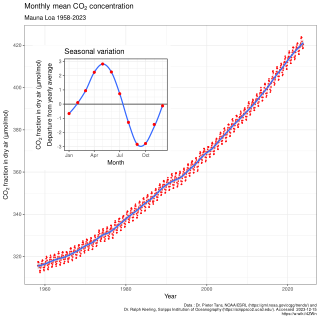
The Keeling Curve is a graph of the accumulation of carbon dioxide in the Earth's atmosphere based on continuous measurements taken at the Mauna Loa Observatory on the island of Hawaii from 1958 to the present day. The curve is named for the scientist Charles David Keeling, who started the monitoring program and supervised it until his death in 2005.
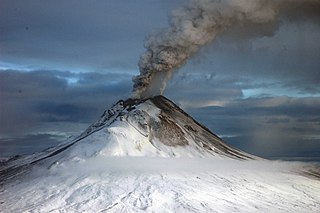
Volcanic gases are gases given off by active volcanoes. These include gases trapped in cavities (vesicles) in volcanic rocks, dissolved or dissociated gases in magma and lava, or gases emanating from lava, from volcanic craters or vents. Volcanic gases can also be emitted through groundwater heated by volcanic action.

The atmosphere of Mars is the layer of gases surrounding Mars. It is primarily composed of carbon dioxide (95%), molecular nitrogen (2.85%), and argon (2%). It also contains trace levels of water vapor, oxygen, carbon monoxide, hydrogen, and noble gases. The atmosphere of Mars is much thinner than Earth's. The average surface pressure is only about 610 pascals (0.088 psi) which is less than 1% of the Earth's value.
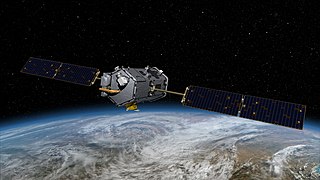
The Orbiting Carbon Observatory (OCO) is a NASA satellite mission intended to provide global space-based observations of atmospheric carbon dioxide. The original spacecraft was lost in a launch failure on 24 February 2009, when the payload fairing of the Taurus rocket which was carrying it failed to separate during ascent. The added mass of the fairing prevented the satellite from reaching orbit. It subsequently re-entered the atmosphere and crashed into the Indian Ocean near Antarctica. The replacement satellite, Orbiting Carbon Observatory-2, was launched 2 July 2014 aboard a Delta II rocket. The Orbiting Carbon Observatory-3, a stand-alone payload built from the spare OCO-2 flight instrument, was installed on the International Space Station's Kibō Exposed Facility in May 2019.

In Earth's atmosphere, carbon dioxide is a trace gas that plays an integral part in the greenhouse effect, carbon cycle, photosynthesis and oceanic carbon cycle. It is one of several greenhouse gases in the atmosphere of Earth. The current global average concentration of CO2 in the atmosphere is 421 ppm as of May 2022 (0.04%). This is an increase of 50% since the start of the Industrial Revolution, up from 280 ppm during the 10,000 years prior to the mid-18th century. The increase is due to human activity. Burning fossil fuels is the main cause of these increased CO2 concentrations and also the main cause of climate change. Other large anthropogenic sources include cement production, deforestation, and biomass burning.
Carbon monitoring as part of greenhouse gas monitoring refers to tracking how much carbon dioxide or methane is produced by a particular activity at a particular time. For example, it may refer to tracking methane emissions from agriculture, or carbon dioxide emissions from land use changes, such as deforestation, or from burning fossil fuels, whether in a power plant, automobile, or other device. Because carbon dioxide is the greenhouse gas emitted in the largest quantities, and methane is an even more potent greenhouse gas, monitoring carbon emissions is widely seen as crucial to any effort to reduce emissions and thereby slow climate change.
Fugitive emissions are leaks and other irregular releases of gases or vapors from a pressurized containment – such as appliances, storage tanks, pipelines, wells, or other pieces of equipment – mostly from industrial activities. In addition to the economic cost of lost commodities, fugitive emissions contribute to local air pollution and may cause further environmental harm. Common industrial gases include refrigerants and natural gas, while less common examples are perfluorocarbons, sulfur hexafluoride, and nitrogen trifluoride.

Greenhouse gases are the gases in the atmosphere that raise the surface temperature of planets such as the Earth. What distinguishes them from other gases is that they absorb the wavelengths of radiation that a planet emits, resulting in the greenhouse effect. The Earth is warmed by sunlight, causing its surface to radiate heat, which is then mostly absorbed by greenhouse gases. Without greenhouse gases in the atmosphere, the average temperature of Earth's surface would be about −18 °C (0 °F), rather than the present average of 15 °C (59 °F).
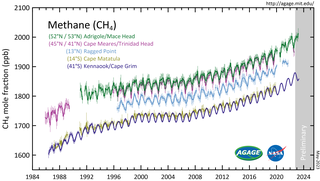
Atmospheric methane is the methane present in Earth's atmosphere. The concentration of atmospheric methane is increasing due to methane emissions, and is causing climate change. Methane is one of the most potent greenhouse gases. Methane's radiative forcing (RF) of climate is direct, and it is the second largest contributor to human-caused climate forcing in the historical period. Methane is a major source of water vapour in the stratosphere through oxidation; and water vapour adds about 15% to methane's radiative forcing effect. The global warming potential (GWP) for methane is about 84 in terms of its impact over a 20-year timeframe. and 28 in terms of its impact over a 100-year timeframe. The global temperature potential for methane is about 4 in terms of its impact over a 100-year timeframe.

Greenhouse gas monitoring is the direct measurement of greenhouse gas emissions and levels. There are several different methods of measuring carbon dioxide concentrations in the atmosphere, including infrared analyzing and manometry. Methane and nitrous oxide are measured by other instruments. Greenhouse gases are measured from space such as by the Orbiting Carbon Observatory and networks of ground stations such as the Integrated Carbon Observation System.
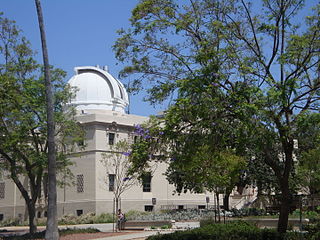
The Total Carbon Column Observing Network (TCCON) is a global network of instruments that measure the amount of carbon dioxide, methane, carbon monoxide, nitrous oxide and other trace gases in the Earth's atmosphere. The TCCON began in 2004 with the installation of the first instrument in Park Falls, Wisconsin, USA, and has since grown to 23 operational instruments worldwide, with 7 former sites.
The atmospheric carbon cycle accounts for the exchange of gaseous carbon compounds, primarily carbon dioxide, between Earth's atmosphere, the oceans, and the terrestrial biosphere. It is one of the faster components of the planet's overall carbon cycle, supporting the exchange of more than 200 billion tons of carbon in and out of the atmosphere throughout the course of each year. Atmospheric concentrations of CO2 remain stable over longer timescales only when there exists a balance between these two flows. Methane, Carbon monoxide (CO), and other man-made compounds are present in smaller concentrations and are also part of the atmospheric carbon cycle.

Orbiting Carbon Observatory-2 (OCO-2) is an American environmental science satellite which launched on 2 July 2014. A NASA mission, it is a replacement for the Orbiting Carbon Observatory which was lost in a launch failure in 2009. It is the second successful high-precision CO2 observing satellite, after GOSAT.
Increasing methane emissions are a major contributor to the rising concentration of greenhouse gases in Earth's atmosphere, and are responsible for up to one-third of near-term global heating. During 2019, about 60% of methane released globally was from human activities, while natural sources contributed about 40%. Reducing methane emissions by capturing and utilizing the gas can produce simultaneous environmental and economic benefits.
Geostationary Carbon Cycle Observatory (GeoCarb) was an intended NASA Venture-class Earth observation mission that was designed to measure the carbon cycle. Originally intended to be mounted on a commercial geostationary communication satellite operated by SES S.A., a lack of hosting opportunities drove NASA to seek a standalone spacecraft to carry GeoCarb. GeoCarb was to be stationed over the Americas and make observations between 50° North and South latitudes. Its primary mission was to conduct observations of vegetation health and stress, as well as observe the processes that govern the carbon exchange of carbon dioxide, methane, and carbon monoxide between the land, atmosphere, and ocean.

The Orbiting Carbon Observatory-3 (OCO-3) is a NASA-JPL instrument designed to measure carbon dioxide in Earth's atmosphere. The instrument is mounted on the Japanese Experiment Module-Exposed Facility on board the International Space Station (ISS). OCO-3 was scheduled to be transported to space by a SpaceX Dragon from a Falcon 9 rocket on 30 April 2019, but the launch was delayed to 3 May, due to problems with the space station's electrical power system. This launch was further delayed to 4 May due to electrical issues aboard Of Course I Still Love You (OCISLY), the barge used to recover the Falcon 9’s first stage. OCO-3 was launched as part of CRS-17 on 4 May 2019 at 06:48 UTC. The nominal mission lifetime is ten years.
XCO2 is the column-averaged of carbon dioxide in the atmosphere, represented in parts per million (ppm). Rather than taking a single observation at the surface, an integration of atmospheric CO2 above a specific location is observed. The 'X' refers to the observation taking place from a satellite platform. CO2 observing satellites cannot observe green house gasses directly, but instead average the entire atmospheric column of CO2. These estimates from satellites need ground truthing to ensure that XCO2 retrievals are accurate, with an average accuracy from OCO 2 and GOSAT of 0.267 ± 1.56 ppm between September 2014 to December 2016.

